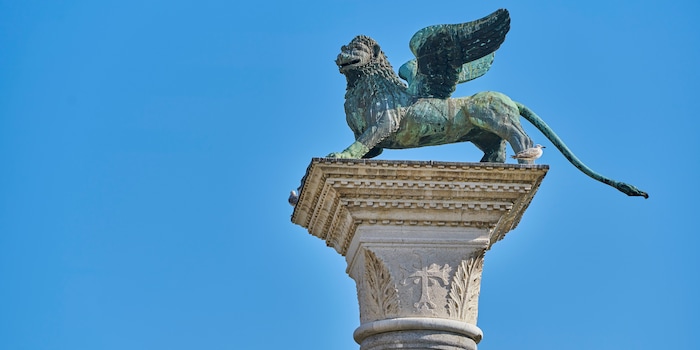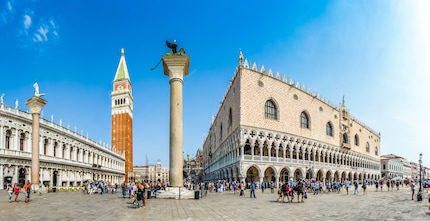
The lion of St Mark's Square comes from China
One of Venice's most famous landmarks turns out to be a medieval import "made in China": The lion on St Mark's Square is a souvenir from the Far East.
The lion enthroned on a column above Venice's Piazza San Marco apparently comes from China. This is what experts from the universities of Padua and Venice have discovered. According to them, the ore for the bronze statue was mined on the lower reaches of the Yangtze. In addition, stylistic features point to the time of the Chinese Tang Dynasty (609-907 AD).
The group of experts now believes that the mystery surrounding the origin of the statue has been solved. Previously, experts had assumed that it could have been made in Anatolia in pre-Christian times. Certain stylistic features had pointed to a Hellenistic origin.
In reality, however, the statue shows more similarities to a typical tomb guardian figure - Chinese: Zhènmùshòu - of the Tang Dynasty, the research team explained at a conference in Venice on 11 September 2024. However, the sculpture was adapted in some places after it was imported. It appears to have originally had horns and much more pointed ears. Overall, the Venetians would have made it more lion-like in comparison to the original appearance.
The statue probably came to Venice in the 13th century. This is according to historical sources. It was apparently dismantled for transport and reassembled in Venice. It was also repeatedly reworked over the following centuries, which further obscured its Chinese origins. For example, the wings were recast in the 19th century, whereby the existing metal from the old wings was recycled.
The scientists have now been led back to China by the isotope signature in the material, a kind of chemical fingerprint of the region of origin. Archaeologist Massimo Vidale from the University of Padua told the magazine "Veneziatoday" that stylistic comparisons are notoriously unreliable, but isotope analyses provide practically unambiguous results. This means that the Far Eastern origin is now "very, very likely". The team is currently preparing a publication in a scientific journal.

Source: Shutterstock - canadastock
The result also raises the question of how the sculpture came to Venice. Marco Polo, the city's most famous traveller to China, is not a possible importer, as the statue was already on its column when he returned from his journey in 1295. However, it could have arrived in the lagoon city as part of the first journey of his father Nicolò and his uncle Maffeo. The two had already travelled the Silk Road between 1264 and 1266 and visited the Mongol court in Beijing. They may have received the centuries-old sculpture there.
Only a few large Zhènmùshòu figures from the Tang dynasty survived the changing power relations in Beijing until the 13th century. Most of them were melted down or destroyed, explains Vidale. It is therefore difficult to find comparable pieces.
There are also few records from Venice about the circumstances under which the statue was erected. Venice chose the winged lion as its symbol between 1260 and 1270. The figure is an attribute of St Mark the Evangelist, the patron saint of the city. However, Vidale suspects that the choice of the lion as the heraldic animal was more a matter of power politics: the winged lion was intended to symbolise the claim to power and the military might of the port city.
Spectrum of science
We are partners of Spektrum der Wissenschaft and want to make well-founded information more accessible to you. Follow Spektrum der Wissenschaft if you like the articles.
Original article on Spektrum.deExperts from science and research report on the latest findings in their fields – competent, authentic and comprehensible.